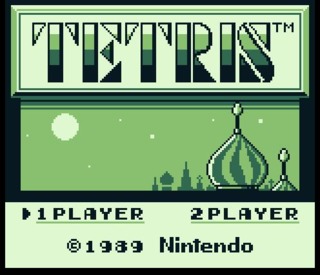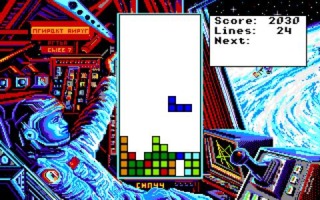Tetris 30th Anniversary Retrospective
There are many beloved video games, but only a rare few manage to permeate mainstream awareness and become cultural icons, and even fewer do so on an international scale. Usually, it's the identity of a main character that average folks latch onto. What about Tetris? The most recognizable imagery from Tetris is a tetromino: a geometric shape composed of four squares, connected orthogonally. Yet, Tetris is one of the most well-known games of all time, and since its inception, it has appeared on almost every device capable of playing games.
The man responsible for creating Tetris is Alexey Pajitnov, a researcher at the Russian Academy of Sciences of the Soviet Union, who in 1984 created the legendary puzzler. From there, Pajitnov's colleague, Vadim Gerasimov, developed a port for the IBM PC, which was later licensed to US publisher Spectrum Holobyte. It was Gerasimov's port that engrained Tetris into American culture, but the game also made its way to other countries, and other platforms, at the hands of cavalier programmers, leading to wild licensing of the Tetris brand in different countries.
The most memorable mishandling of the Tetris license took place in America, where publisher Tengen (Atari's console division) released a version of Tetris for the Nintendo Entertainment System. Nintendo was none too happy; Tengen licensed Tetris from a party without the rights to sell it, and Nintendo itself had appropriately and legally secured rights to its own NES port. The dispute led to a lawsuit that would eventually end in Nintendo's favor, and Tengen was forced to recall all copies of its game. The takeaway: Tetris is a valuable property with global appeal, and people are willing to lie, steal, and sue in order to wield its popularity. For the players, none of this mattered.
Here's what Tetris means to us.
Chris Watters
Tetris entered my life on the Apple IIGS, my family's first computer. The "family" distinction is important here, because one look at the leaderboard would tell you that I wasn't the only one who developed an obsession with the burgeoning classic. Though Tetris was primarily a struggle against myself--the version I played wouldn't stop until the ever-increasing drop speed made it impossible to keep up--striving to best my mom or my dad gave me my first taste of the competitive thrill of gaming. Going to bed with a chart-topper gave me such sweet satisfaction, though it irked me that my dad didn't have an enforced bedtime keeping him from playing one more round.
That "one more round" impulse is indicative of just how engrossing Tetris can be. Getting into the flow of spotting the piece, analyzing the matrix, moving the piece into place, and then dropping it to bring on the next one becomes an almost meditative exercise. A good Tetris round is an utterly absorbing experience in which you tune out the world around you, which makes it even more remarkable that it can also give rise to such cutthroat competition.
Fast-forward to college, and The New Tetris has arrived on the Nintendo 64. My friend has four controllers and a penchant for trash-talking, so I rise to the challenge and step in to show off my formidable skills. My first match is a total debacle as I get snowed under by the new block-fusing mechanic and by my friend's own formidable skills. I was hooked. The challenge of individual performance and the thrill of competition from my childhood came rushing back, reborn for a new period in my life and a new crop of competitors. Tetris had changed, but the joy that it brought into my life was as bright as ever. And my friend? A decade later, I married her.
Peter Brown

My first taste of Tetris was on the Nintendo Entertainment System, but it belonged to my older brother, so I spent most of my time just watching him play. It wasn't until I received a Game Boy for my sixth birthday (in 1991) that I had a copy of my very own. It came into my life along with Mega Man's first portable outing, but Dr. Wily was too much of a challenge for 6-year-old me, so it would be Tetris that I played night after night, cloaked under my bedsheets with whatever source of light I could muster. I can still recall the playful sounds of "korobeiniki," or to most of us, "the Tetris song," and the rewarding tones that played when you cleared four lines in a row, appropriately enough referred to as a "Tetris." My fondness for tetrominos led me to Daedilian Opus--another Game Boy puzzle game that happened to use similar geometrical shapes, but it didn't hold my attention like the real deal. It didn't take me long to revert back to my old ways, and frankly, to the better game.
Tetris played a different role in my life during high school, where it was once again a clandestine activity. By our sophomore year, everyone was required to carry a TI-82 graphic calculator, and the great thing about that was that with the right cable, you could install a wide array of free software from a connected computer, and as you can probably guess, installing Tetris was priority number one for a lot of us. Some teachers would eventually catch on to the fact that most of their students were busy assembling blocks rather than plotting curves and graphs, but for the most part, almost everyone spent some amount of time playing Tetris in secret on a daily basis. Leaderboards didn't exist, either online or on paper, so we ranked one another via word of mouth. Like a game of telephone, word of high scores spread through the hallways, changing a little bit with each new messenger. It came as no surprise to me when I finally learned about national Tetris competitions, but the reflexes of champion Tetris players made our attempts at greatness look like child's play.
Now, Tetris is everywhere. Every computer, game console, and telephone that has crossed my path since seems to have its own version, and it will probably go down in history as one of the most popular video games ever created. Having grown up with Tetris, seeing it succeed on such a large scale is nothing short of gratifying. Who knew 6-year-old me had such good taste!

Randolph Ramsay
Could Tetris be the greatest game of all time? There have certainly been plenty who have claimed that in the past, and if you measure these types of things in terms of cultural impact, then few games can match Tetris. Ubiquity is certainly a key part of this--since 1984, versions of Tetris have appeared on countless devices in countless forms, so much so that it doesn't feel like hyperbole to say that everybody--everybody--has played Tetris before.
But there's a reason the game is so ubiquitous. Tetris is, quite simply, one of the most welcoming games ever made. It's simple and complex and shallow and deep all at the same time. It takes a minute to learn everything you need to know to play the game, but weeks or maybe months to become skillful. And the game is simply fun no matter how much you put into it, whether that's a few minutes on a bus, half an hour on the couch at home, or hours on a long plane ride.
I first came across Tetris in 1990, when a friend managed to score himself a nifty new Game Boy. He had plenty of other games that we played, but the only one I remember to this day is Tetris. Since then, I've played it on multiple platforms, and I'll likely continue to go back to it for many more years to come. Long after the likes of Angry Birds or Call of Duty or Grand Theft Auto or other recent games that have hit mainstream consciousness have faded, Tetris will still be around. And there's good reason for that.
Does Tetris hold a special place in your heart? When was the first time you hummed korobeiniki without realizing it? Let us know in the comments below.









